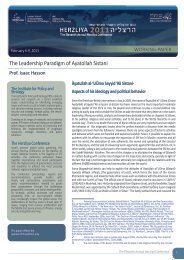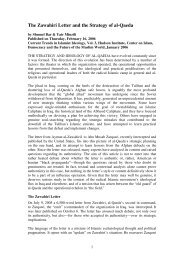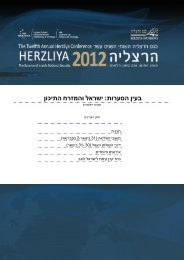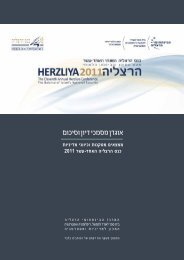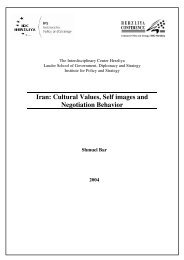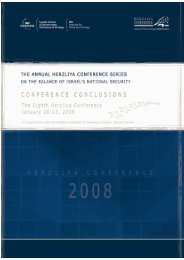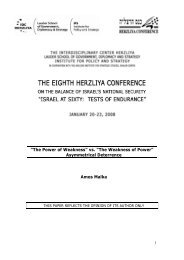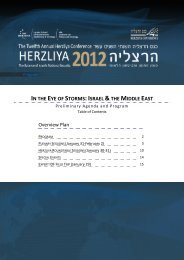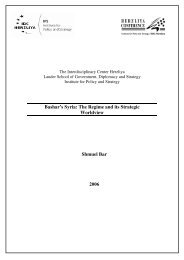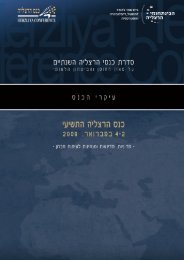Classical Islamic Paradigms of Deterrence and their Expression in ...
Classical Islamic Paradigms of Deterrence and their Expression in ...
Classical Islamic Paradigms of Deterrence and their Expression in ...
You also want an ePaper? Increase the reach of your titles
YUMPU automatically turns print PDFs into web optimized ePapers that Google loves.
territory, <strong>and</strong> only the broad target<strong>in</strong>g <strong>of</strong> the civilian population among which the enemy advances,promises victory, then the rule <strong>of</strong> the <strong>in</strong>violability <strong>of</strong> Muslim blood (hurmat dima' al-muslim<strong>in</strong>) may beconditionally overruled by the necessity to protect Dar al-Islam (The Abode <strong>of</strong> Islam). Another example <strong>of</strong>an orig<strong>in</strong>al case to justify the kill<strong>in</strong>g <strong>of</strong> Muslims with an analogy is that the enemy shields himself withMuslim civilians, or that byst<strong>and</strong>ers belong to the enemy’s entourage (tatarrus). This reason<strong>in</strong>g was appliedby the <strong>Islamic</strong> Jihad Organization to justify the assass<strong>in</strong>ation <strong>of</strong> President Anwar al-Sadat <strong>in</strong> 1981. 102The classical legal <strong>in</strong>terpretation goes back to the advances <strong>of</strong> Mongol <strong>in</strong>vaders <strong>in</strong>to the Abbassidecaliphate <strong>in</strong> the 13 th century AD <strong>and</strong> has been picked up by numerous contemporary jihadi ideologues tojustify terrorist attacks, <strong>in</strong> which the likelihood <strong>of</strong> civilian casualties is very high. Non-Muslim civilians maybe killed because they <strong>in</strong>directly support the enemy with <strong>their</strong> work <strong>and</strong> are part <strong>of</strong> his war-mach<strong>in</strong>ery,which also goes back to classic salafi-jihadi <strong>in</strong>terpretations <strong>of</strong> <strong>Islamic</strong> legal stipulations such as "The Rul<strong>in</strong>gs<strong>of</strong> the Qur’an" by the medieval scholar Ibn al-'Arabi, who states "Do not kill women unless they fight,because the Prophet, peace be upon him, forbade <strong>their</strong> kill<strong>in</strong>g. And this is valid for as long as they do notfight, for if they fight, then they will be killed." 103Interpretations <strong>of</strong> two classical Muslim scholars 104 on the s<strong>in</strong>gle attack dur<strong>in</strong>g the siege <strong>of</strong> Constant<strong>in</strong>ople <strong>in</strong>674 deserve special attention. The reason<strong>in</strong>g is cha<strong>in</strong>-like, starts with a tradition (hadith), is cont<strong>in</strong>ued byclassical scholars, <strong>and</strong> f<strong>in</strong>ally <strong>in</strong>tegrated <strong>in</strong>to contemporary <strong>Islamic</strong> deterrence concepts based on terroristtactics. The above quoted hadith expla<strong>in</strong>s the event itself. It is the root source for the <strong>in</strong>terpretations.<strong>Classical</strong> Muslim scholars <strong>in</strong>terpret the event <strong>in</strong> a deterrence context. Furthermore, the classical<strong>in</strong>terpretation <strong>of</strong> s<strong>in</strong>gle attacks has become a cornerstone <strong>in</strong> the justification <strong>of</strong> contemporary suicideattacks. Suicide-attacks are analogized to s<strong>in</strong>gle attacks such as the one at the siege <strong>of</strong> Constant<strong>in</strong>ople <strong>in</strong>674. Furthermore, suicide-attacks are supposed to "frighten" the enemy, which also follows the medieval<strong>in</strong>terpretation <strong>of</strong> s<strong>in</strong>gle attacks. The classical discussion <strong>of</strong> s<strong>in</strong>gle attacks (<strong>in</strong>ghimas; iqtiham) 105 <strong>in</strong> relation to"self-destruction" (tahluka; talaf al-nafs) sheds more light on this topic. <strong>Classical</strong> <strong>Islamic</strong> law states that selfsacrificeis legitimate if it serves the motivation <strong>of</strong> Muslims <strong>and</strong> deterrence <strong>of</strong> enemies: 106• Al-Shaybani said: If one man alone launched an attack aga<strong>in</strong>st thous<strong>and</strong> men from the idolaters <strong>and</strong> hewas alone, there wouldn’t be a virtue <strong>in</strong> this, if he strives for save rescue, or the destruction (nikaya) <strong>of</strong> theenemy. Therefore, he has no option <strong>and</strong> he is reprehensible, if he turns himself to the destruction without abenefit (manfa'a) for the Muslims. If his <strong>in</strong>tention is to encourage the Muslims to do it like him, thepermissibility will be likely, because it is a benefit for the Muslims from some po<strong>in</strong>ts <strong>of</strong> view (fih<strong>in</strong>af'an…'ala ba'ad al-wujuh). And if his <strong>in</strong>tention is the frighten<strong>in</strong>g (irhab) <strong>of</strong> the enemy <strong>in</strong> order to teachhim about the firmness (salaba) <strong>of</strong> the Muslims <strong>in</strong> the religion, then the permissibility is likely.• If there is a benefit for the Muslims, the life is destroyed for the strengthen<strong>in</strong>g <strong>of</strong> the religion <strong>of</strong> Allah (fatulifatal-nafs li-i'zaz d<strong>in</strong> Allah), <strong>and</strong> the discouragement <strong>of</strong> atheism (tawh<strong>in</strong> al-kufr). Allah praises that the102 Sadat was sitt<strong>in</strong>g among a large entourage, watch<strong>in</strong>g a military parade that celebrated the Egyptian "victory" aga<strong>in</strong>st Israel <strong>in</strong> the 1973war, when the attack took place.103 Abu Mus'ab al-Suri, "Da'wat al-Muqawama al-Islamiyya al-'Alamiyya" ("Global <strong>Islamic</strong> Resistance Call"), p. 1228.104 Muhammad b<strong>in</strong> al-Hasan al-Shaybani (749/50 - 805) <strong>and</strong> Abu Abdullah Muhammad ibn Ahmad ibn Abu Bakr al-Ansari al-Qurtubi (1214 -1274) were famous Sunni scholars. The former belongs to the Hanafi school <strong>and</strong> the latter to the Maliki school <strong>of</strong> <strong>Islamic</strong> jurisprudence.105 The penetration <strong>of</strong> the s<strong>in</strong>gle man <strong>in</strong>to the enemy is termed iqtiham. The term is an eighth form verbal noun derived from the root wordqaham <strong>and</strong> means <strong>in</strong>trud<strong>in</strong>g, but also defy<strong>in</strong>g a danger, or hardship. Another term is <strong>in</strong>ghimas, a seventh form verbal noun <strong>of</strong> itscorrespond<strong>in</strong>g word root rhayn-mim-s<strong>in</strong>, which literally means to plunge <strong>in</strong>to the enemy. Thus, the matter <strong>of</strong> dispute (ikhtilaf) amongMuslim jurisprudents is the permissiveness <strong>of</strong> the <strong>in</strong>trusion or plung<strong>in</strong>g <strong>of</strong> the man <strong>in</strong>to the enemy <strong>in</strong> the war, <strong>and</strong> his s<strong>in</strong>gle attack aga<strong>in</strong>stmany <strong>of</strong> the enemy (jawaz iqtiham; <strong>in</strong>ghimas al-rajul fi-l-harb, wa hamluhu 'ala- l-'adu –l- kathir wahdahu).106 Ibrahim al-'Ali, "Hawla "al-'amaliyat al-istishhadiyya," Filast<strong>in</strong> al-Muslima, part 1: October 1995, pp. 51-52; part 2: November 1995, pp.52-53; part 3: December 1995, pp. 51-52. See also: Philipp Holtmann, "Martyrdom, not Suicide: The Legality <strong>of</strong> Hamas’ Bomb<strong>in</strong>gs <strong>in</strong> themid-1990s <strong>in</strong> Modern <strong>Islamic</strong> Jurisprudence", Munich, Gr<strong>in</strong>, 2009.30



